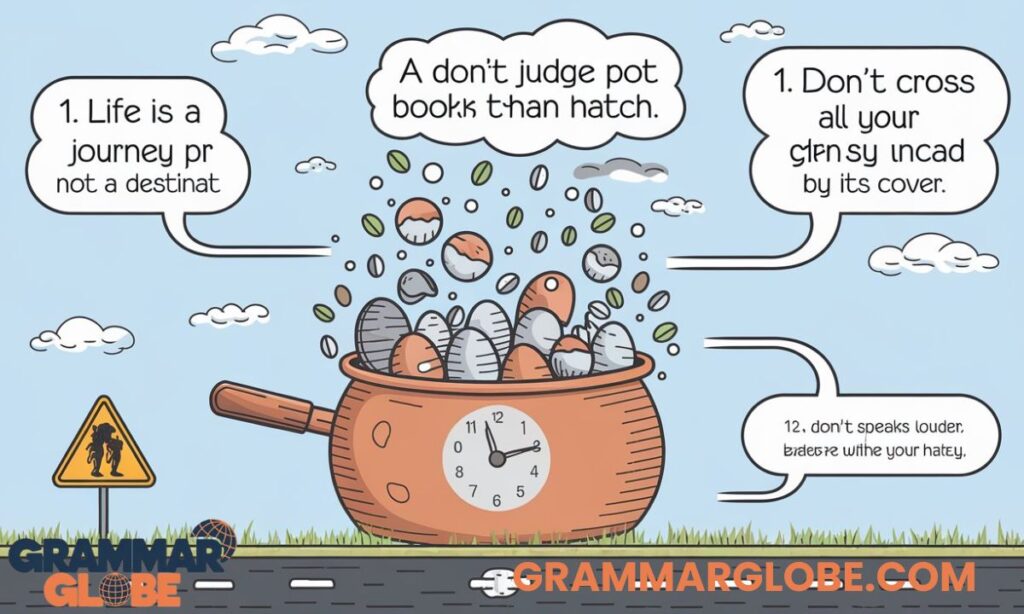In the vast landscape of language, Metaphor Examples stand as vibrant beacons, illuminating our thoughts and painting vivid pictures with words. These powerful figures of speech have the uncanny ability to transform complex ideas into relatable concepts, making them indispensable tools for writers, speakers, and thinkers alike.
In this comprehensive guide, we’ll dive deep into the world of metaphors, exploring their types, examining 100 metaphor examples, and uncovering the secrets to crafting compelling comparisons that will elevate your communication skills.
Before we embark on our journey through 100 Metaphor Examples (Common Example Sentences), let’s first understand what exactly a metaphor is and why it holds such a crucial place in our linguistic toolkit.
Definition and Purpose
A metaphor is a figure of speech that describes an object or action in a way that isn’t literally true, but helps explain an idea or make a comparison. Unlike similes, which use “like” or “as” to make explicit comparisons, metaphors imply or state a direct comparison without these connecting words.
“The world is but a stage, and every man and woman is simply a player.” – William Shakespeare
This famous quote from Shakespeare’s “As You Like It” is a perfect example of how metaphors can encapsulate complex ideas in a concise, memorable way. By comparing life to a theatrical performance, Shakespeare invites us to consider the roles we play and the transient nature of our existence.
The Cognitive and Emotional Impact of Metaphors
Metaphors aren’t just flowery language; they serve a vital cognitive function. Research in cognitive linguistics has shown that metaphors shape our understanding of abstract concepts by grounding them in more concrete, physical experiences. For instance, when we say “I see what you mean,” we’re using a visual metaphor to describe understanding, linking the abstract concept of comprehension to the concrete act of seeing.
Moreover, metaphors have a powerful emotional impact. They can:
- Evoke strong feelings and memories
- Create vivid mental images
- Make complex ideas more accessible
- Enhance persuasive communication
- Foster empathy and connection
The Colorful Palette of Metaphor Types
Just as a painter uses different brushes and techniques to create a masterpiece, writers and speakers employ various types of metaphors to craft their messages. Let’s explore the diverse world of metaphor types, each with its unique characteristics and applications.
Simple Metaphors: The Building Blocks
Simple metaphors are the foundation of figurative language. They make a direct comparison between two unlike things, stating that one thing is another.
Example: “Life is a roller coaster.”
This metaphor compares the ups and downs of life to the thrilling ride of a roller coaster, conveying the idea of life’s unpredictability and excitement.
Extended Metaphors: Painting a Larger Picture
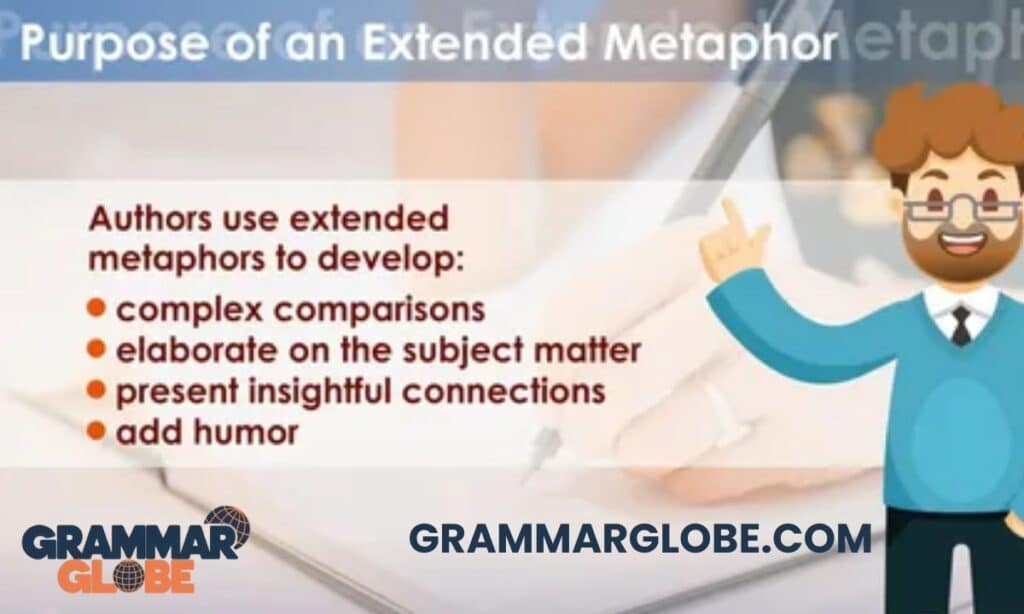
An extended metaphor is a comparison that continues over multiple sentences or even paragraphs, exploring various aspects of the two subjects being compared.
Example: “Love is a journey. It begins with a single step, winds through unexplored territories, and leads to breathtaking vistas. Along the way, travelers face obstacles, discover hidden treasures, and sometimes lose their way. But with perseverance and a trusty map of the heart, lovers can navigate even the roughest terrain.”
This extended metaphor compares love to a journey, elaborating on various aspects of relationships through the lens of travel and exploration.
Implied Metaphors: Reading Between the Lines
Implied metaphors make a comparison without explicitly stating one of the terms. They require the reader to infer the unstated element of the comparison.
Example: “His words cut deep.”
Here, the implied comparison is between words and a sharp object, suggesting that the person’s speech was hurtful without directly stating it.
Dead Metaphors: Ghosts of Figurative Past
Dead metaphors are phrases that were once vivid metaphors but have lost their impact through overuse. They’ve become so ingrained in everyday language that we often forget their metaphorical origins.
Example: “Time is running out.”
This once-powerful metaphor comparing time to a finite resource has become so common that we rarely consider its figurative nature.
Mixed Metaphors: A Double-Edged Sword
Mixed metaphors occur when two or more incompatible metaphors are combined, often with unintentionally humorous results.
Example: “He’s burning the candle at both ends, but it’s not rocket science.”
This sentence mixes metaphors about overworking oneself with a phrase about simplicity, creating a somewhat confusing image.
Absolute Metaphors: Beyond Logical Comparison
Absolute metaphors, also known as paralogical metaphors, make comparisons between two things that have no obvious connection, creating striking and often surreal images.
Example: “Consciousness is a broken mirror.”
This comparison between consciousness and a broken mirror doesn’t have a clear logical connection, inviting the reader to ponder its meaning.
Synesthetic Metaphors: A Feast for the Senses
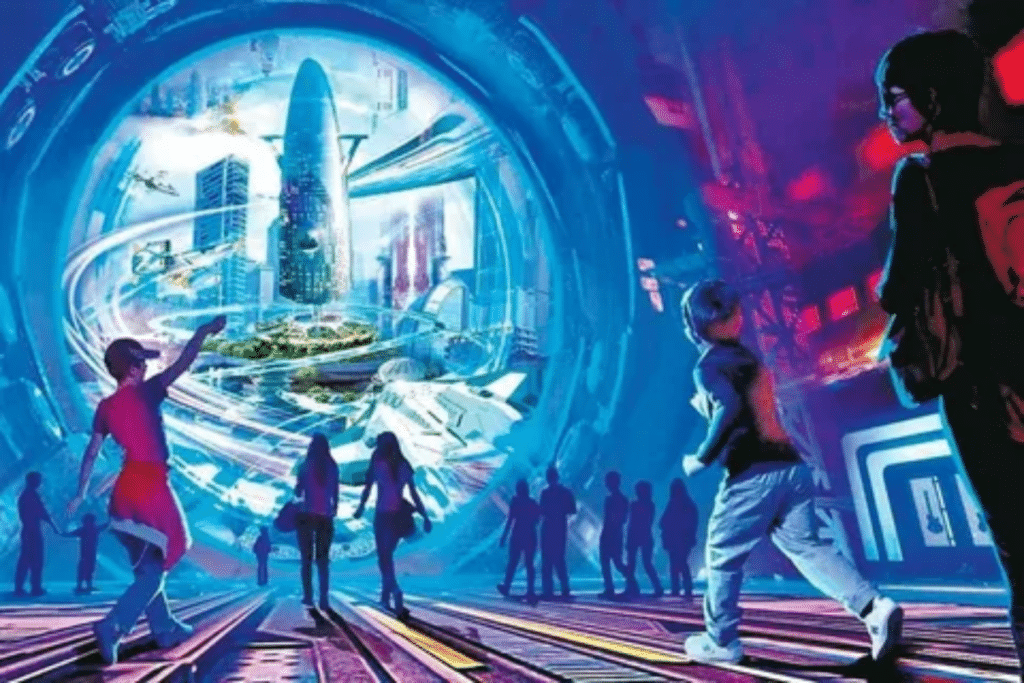
Synesthetic metaphors blend different sensory experiences, describing one sense in terms of another.
Example: “Her voice was velvet.”
This metaphor combines the auditory experience of a voice with the tactile sensation of velvet.
Conceptual Metaphors: Shaping Our Understanding
Conceptual metaphors are underlying comparisons that structure our thinking about abstract concepts in terms of more concrete experiences.
Example: “Argument is war.”
This conceptual metaphor shapes how we think and talk about arguments, using terms like “defend,” “attack,” “win,” or “lose” when discussing verbal disputes.
100 Metaphor Examples: A Journey Through Figurative Language
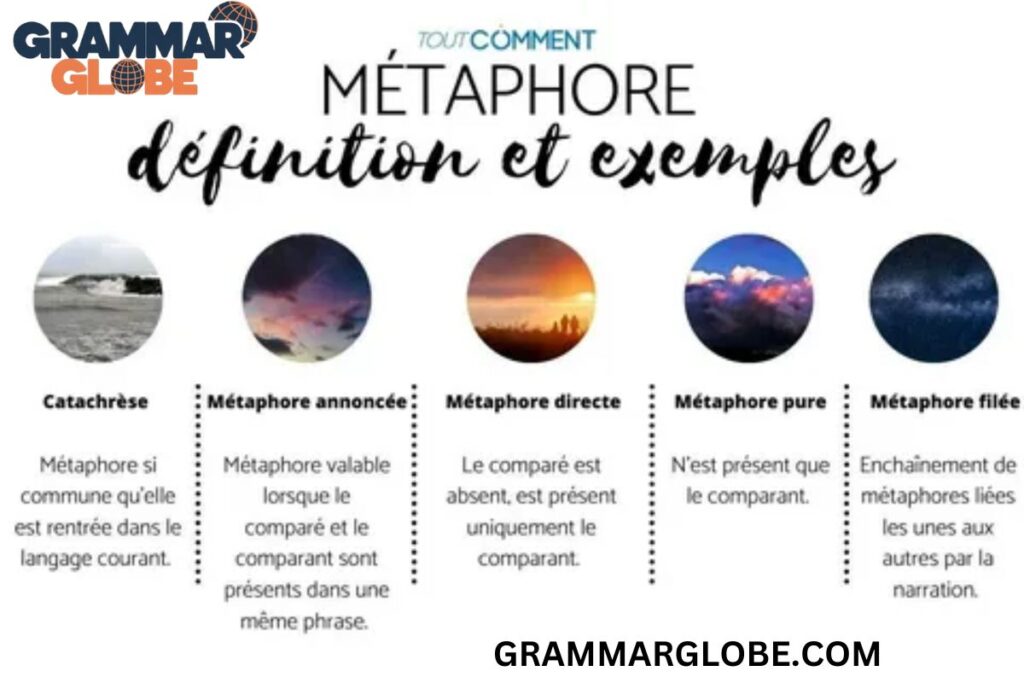
Now that we’ve explored the various types of metaphors, let’s dive into our collection of 100 Metaphor Examples (Common Example Sentences). These examples will showcase how metaphors enrich our language across different domains.
If you have your favorite metaphorical phrase, you can choose to go to GSJJ to customize stickers to show your personality declaration.
Custom stickers can not only choose rich colors but also choose your favorite shape and size. In terms of material, we use waterproof and wear-resistant high-quality paper to ensure that the stickers are durable and bright. In addition to metaphorical phrases, you can also customize your favorite patterns on stickers. Stickers are also widely used. Whether it is a notebook, a water cup, a car body, or a computer, it can become a stage for you to show your personality.
Custom stickers make every expression of yours full of power and warmth. Come to GSJJ for customization!
Metaphors in Everyday Speech
- “She’s a night owl.”
- “Life is a highway.”
- “He’s a couch potato.”
- “Time is money.”
- “Her eyes were diamonds.”
- “The news hit him like a ton of bricks.”
- “He’s a walking dictionary.”
- “The classroom was a zoo.”
- “His heart is made of stone.”
- “She’s a ray of sunshine.”
- “The world is my oyster.”
- “He’s a bull in a china shop.”
- “Her voice is music to my ears.”
- “The city is a concrete jungle.”
- “That child is a little angel.”
- “He’s a wolf in sheep’s clothing.”
- “Her smile is a warm blanket.”
- “The computer has a virus.”
- “Life is a rollercoaster.”
- “He’s drowning in paperwork.”
- “She’s a social butterfly.”
- “The news spread like wildfire.”
- “His mind is a steel trap.”
- “The athlete is a machine.”
- “Her anger is a volcano ready to erupt.”
Metaphors in Literature and Poetry
- “Hope is the thing with feathers” – Emily Dickinson
- “All the world’s a stage” – William Shakespeare
- “Life’s but a walking shadow” – William Shakespeare
- “Love is a battlefield” – Pat Benatar
- “The sun was a toddler insistently refusing to go to bed” – John Green
- “My love is a red, red rose” – Robert Burns
- “The moon was a ghostly galleon tossed upon cloudy seas” – Alfred Noyes
- “Fame is a bee” – Emily Dickinson
- “The fog comes on little cat feet” – Carl Sandburg
- “Life is a broken-winged bird that cannot fly” – Langston Hughes
- “The wind was a torrent of darkness among the gusty trees” – Alfred Noyes
- “Hope is the thing with feathers that perches in the soul” – Emily Dickinson
- “The sky is low, the clouds are mean” – Emily Dickinson
- “The stars were diamonds in the sky” – Various
- “April is the cruelest month” – T.S. Eliot
- “The yellow fog that rubs its back upon the window-panes” – T.S. Eliot
- “Life is a broken-winged bird that cannot fly” – Langston Hughes
- “The world is a stage and the play is badly cast” – Oscar Wilde
- “All our words are but crumbs that fall down from the feast of the mind” – Khalil Gibran
- “The moon is a white strange world” – Shirley Jackson
- “Books are the mirrors of the soul” – Virginia Woolf
- “Jealousy is a green-eyed monster” – William Shakespeare
- “Life is a tale told by an idiot” – William Shakespeare
- “The sun is a golden eye” – Sylvia Plath
25 Metaphors in Business and Politics
- “Time is money.”
- “The market is a roller coaster.”
- “He’s a shark in the business world.”
- “The economy is on life support.”
- “This deal is a slam dunk.”
- “The political landscape is a minefield.”
- “Her speech was a home run.”
- “The negotiations hit a brick wall.”
- “The company is a sinking ship.”
- “He’s climbing the corporate ladder.”
- “The new policy is a band-aid solution.”
- “The election was a landslide victory.”
- “The stock market is a casino.”
- “This project is a ticking time bomb.”
- “The politicians are playing chess with people’s lives.”
- “The budget cuts are a bitter pill to swallow.”
- “The company is a well-oiled machine.”
- “The tax loophole is a golden parachute for the wealthy.”
- “The start-up is a unicorn in the making.”
- “The merger was a marriage of convenience.”
- “The new regulation is a double-edged sword.”
- “The campaign trail is a marathon, not a sprint.”
- “The economy is a fragile ecosystem.”
- “The company’s growth strategy is a roadmap to success.”
- “The political debate was a boxing match.”
Metaphors in Science and Technology
- “The brain is a computer.”
- “DNA is the blueprint of life.”
- “The immune system is an army.”
- “The heart is a pump.”
- “The cell is a factory.”
- “The internet is an information superhighway.”
- “Genes are switches.”
- “The universe is an ocean.”
- “Black holes are cosmic vacuum cleaners.”
- “The atom is a miniature solar system.”
- “The greenhouse effect is a blanket around the Earth.”
- “Viruses are invaders.”
- “The Big Bang was the birth of the universe.”
- “The Earth is a spaceship.”
- “Enzymes are biological catalysts.”
- “The mind is a garden.”
- “The body is a machine.”
- “Neurons are the wiring of the brain.”
- “Evolution is a tree of life.”
- “The ecosystem is a web.”
- “Climate change is a ticking time bomb.”
- “The human genome is a book of life.”
- “The universe is a cosmic dance.”
- “Quantum entanglement is a spooky action at a distance.”
- “The Higgs boson is the God particle.”
The Art of Crafting Effective Metaphors
Now that we’ve explored a wealth of 100 Metaphor Examples (Common Example Sentences), let’s delve into the art of crafting your own powerful metaphors. Creating effective metaphors is a skill that can elevate your writing and communication to new heights.
Tips for Creating Memorable Metaphors
- Find common ground: Look for unexpected connections between the subject you’re describing and something more familiar or concrete.
- Appeal to the senses: Use vivid sensory details to make your metaphors more engaging and memorable.
- Keep it fresh: Avoid clichés and overused comparisons. Strive for originality in your metaphors.
- Consider your audience: Choose metaphors that will resonate with your readers or listeners based on their experiences and knowledge.
- Use specific, concrete images: The more specific your metaphor, the more powerful it will be.
Common Pitfalls to Avoid
- Mixed metaphors: Be careful not to combine incompatible metaphors, as this can confuse your audience.
- Overuse: While metaphors are powerful, using too many can overwhelm your writing. Use them judiciously for maximum impact.
- Forced comparisons: Ensure your metaphors feel natural and enhance understanding rather than complicating it.
- Culturally insensitive metaphors: Be aware of cultural differences and avoid metaphors that might be offensive or misunderstood in different contexts.
- Overextending metaphors: Know when to let go of a metaphor. Extending it too far can weaken its impact.
Exercises to Improve Metaphor-Making Skills
- Object association: Choose a random object and list as many comparisons as you can think of in five minutes.
- Metaphor scavenger hunt: Look for metaphors in your daily life, from conversations to advertisements. Analyze why they work (or don’t).
- Abstract to concrete: Take an abstract concept (like love, time, or justice) and create metaphors using concrete, everyday objects.
- Sensory metaphors: Describe one sensory experience using terms from another sense (e.g., describing a sound in terms of taste).
- Metaphor expansion: Take a simple metaphor and expand it into an extended metaphor, exploring different aspects of the comparison.
Metaphors Across Cultures
As we continue our exploration of 100 Metaphor Examples (Common Example Sentences), it’s important to recognize that metaphors are not universal. They can vary significantly across cultures, reflecting different worldviews, traditions, and experiences.
How Metaphors Vary in Different Languages
Metaphors are deeply rooted in cultural experiences and linguistic traditions. For example:
- In English, we might say “time is money,” reflecting a cultural emphasis on productivity.
- In Spanish, “dar calabazas” (to give pumpkins) means to reject a romantic advance.
- In Chinese, “drawing a snake and adding feet” means to ruin something by unnecessary embellishment.
These differences highlight the importance of understanding cultural context when interpreting or translating metaphors.
Universal Metaphors and Their Significance
Despite cultural differences, some metaphors appear to be nearly universal. These often relate to basic human experiences and perceptions. For example:
- “Life is a journey” is a concept found in many cultures.
- Associating “up” with positive emotions and “down” with negative ones is common across languages.
These shared metaphors suggest some commonalities in human cognition and experience across cultures.
The Role of Metaphors in Cross-Cultural Communication
Understanding metaphors is crucial for effective cross-cultural communication. Misinterpreting or misusing metaphors can lead to misunderstandings or even offense. When communicating across cultures:
- Be aware of potential differences in metaphorical language.
- Explain metaphors that might not be familiar to your audience.
- Use metaphors judiciously, opting for more literal language when clarity is paramount.
The Science Behind Metaphors
The study of metaphors isn’t just a matter for linguists and writers. Cognitive scientists and neuroscientists have been exploring how our brains process metaphors, revealing fascinating insights into human cognition.
Metaphor Theory And Cognitive Linguistics
Cognitive linguists, led by pioneers like George Lakoff and Mark Johnson, have proposed that metaphors are not just linguistic devices but fundamental to how we think and understand the world. Their Conceptual Metaphor Theory suggests that:
- Abstract concepts are understood through more concrete experiences.
- Many of our basic metaphors are rooted in physical experiences.
- Metaphors shape our perception and reasoning about abstract concepts.
For example, the conceptual metaphor “More is Up” (as in “prices are rising”) is thought to be based on the physical experience of seeing pile grow higher as more is added to it.
How the Brain Processes Metaphor Examples
Neuroscientific research has provided insights into how our brains handle metaphors:
- Both literal and metaphorical language activate similar brain regions.
- Novel metaphors tend to activate the right hemisphere more than conventional ones.
- Processing metaphors involves areas of the brain associated with sensory experiences and emotion.
This research supports the idea that metaphors are more than just linguistic flourishes – they’re integral to how we think and feel.
The Role of Metaphors in Learning and Memory
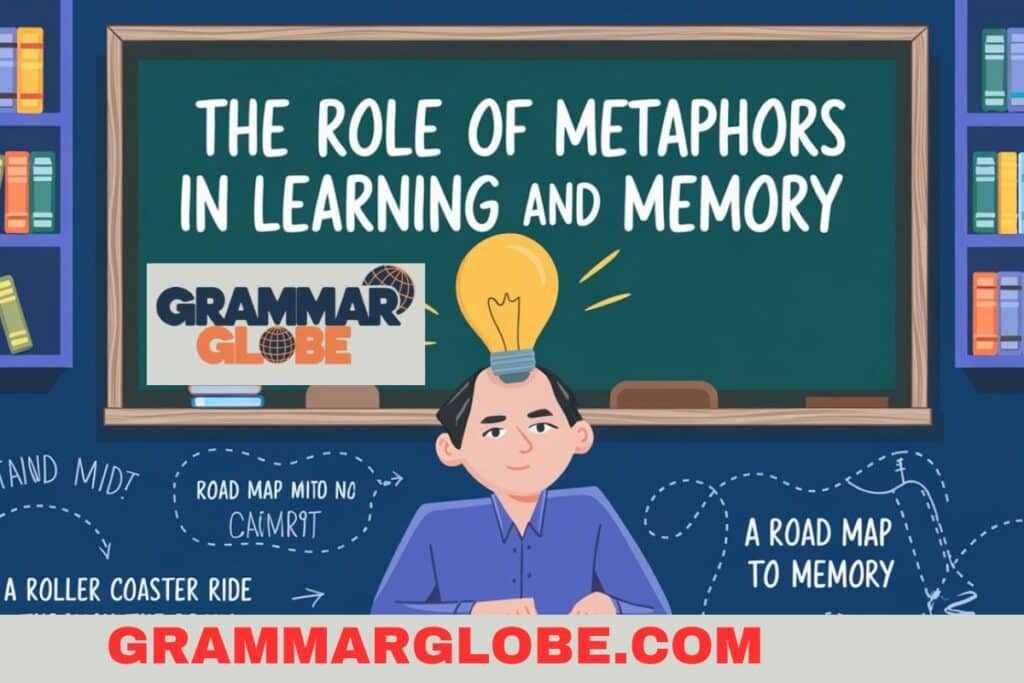
Metaphors play a crucial role in learning and memory:
- They can make abstract concepts more concrete and memorable.
- They provide a framework for understanding new information.
- They can evoke emotional responses, which can enhance memory formation.
Educators and communicators can leverage this by using appropriate metaphors to explain complex ideas and enhance retention.
Metaphor Examples in the Digital Age
As we move further into the digital age, our use and understanding of metaphors are evolving. Let’s explore how technology is shaping our metaphorical language and thinking.
How Technology is Changing Our Metaphors
The digital revolution has introduced new metaphors and repurposed old ones:
- We “surf” the web and “stream” content.
- Computers have “memory” and can “think.”
- We “upload” our consciousness to the “cloud.”
These metaphors reflect our attempts to understand new technologies through familiar concepts.
Metaphors in User Interface Design
Metaphors play a crucial role in making technology user-friendly:
- The “desktop” metaphor in computer interfaces
- “Folders” for organizing digital files
- “Cut” and “paste” for manipulating text
These metaphors help users understand how to interact with abstract digital systems by relating them to familiar physical objects and actions.
The Future of Metaphors in an AI-Driven World
As AI becomes more prevalent, new metaphors are emerging:
- AI as a “black box”
- Machine learning algorithms that “learn” and “evolve”
- The concept of “artificial neural networks”
These metaphors help us grapple with complex technologies, but they can also shape (and sometimes limit) our understanding of AI’s capabilities and limitations.
FAQs: Demystifying Metaphors
As we wrap up our exploration of 100 Metaphor Examples (Common Example Sentences), let’s address some frequently asked questions about metaphors.
How do I identify a metaphor in text?
Look for comparisons between unlike things without using “like” or “as.” If something is described as being something else, it’s likely a metaphor.
Can metaphors be overused?
Yes, overusing metaphors can make writing feel forced or confusing. Use them judiciously for maximum impact.
Are metaphors and analogies the same thing?
While related, they’re not identical. Metaphors state that one thing is another, while analogies explain how one thing is like another in some way.
How can I use metaphors effectively in my writing?
Use metaphors to clarify complex ideas, evoke emotions, or create vivid imagery. Ensure they’re relevant to your audience and fit naturally in your writing.
What’s the difference between a metaphor and an idiom?
Metaphors make direct comparisons, while idioms are phrases with figurative meanings that aren’t directly related to the words used.
Conclusion: The Endless Ocean of Metaphors
As we’ve seen through our exploration of 100 Metaphor Examples (Common Example Sentences), metaphors are far more than just literary devices. They’re fundamental tools of human thought and communication, shaping how we understand and interact with the world around us.
From the simple metaphors we use in everyday speech to the complex conceptual metaphors that underpin our understanding of abstract ideas, these figures of speech enrich our language and expand our cognitive horizons. They allow us to express the inexpressible, to make the abstract concrete, and to find common ground in our shared human experiences.
As you continue your journey through the landscape of language, remember that every metaphor you encounter or create is an opportunity to see the world in a new light. Whether you’re a writer crafting vivid prose, a teacher explaining complex concepts, or simply someone looking to communicate more effectively, the art of metaphor is a powerful tool at your disposal.
So dive into the ocean of metaphors, let your imagination soar on the wings of figurative language, and watch as your ideas blossom into vibrant gardens of understanding. The world of metaphors is yours to explore, one comparison at a time.

Oliver Smith is an experienced blogger at Grammar Globe, Oliver Smith, an expert in English grammar and a master of wit, brings language to life with his playful take on puns. Through his works, he weaves humor into the rules of grammar, making learning fun and engaging for readers of all ages. Discover language with a smile!”

